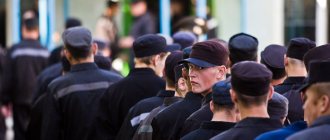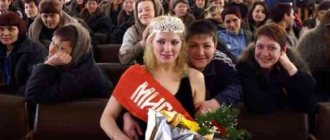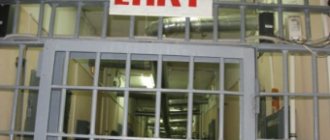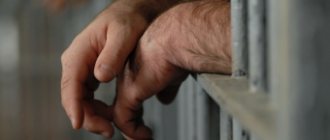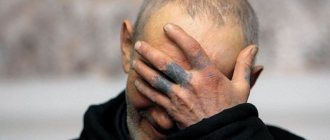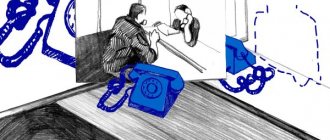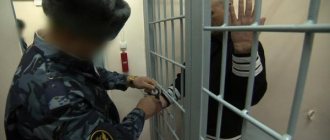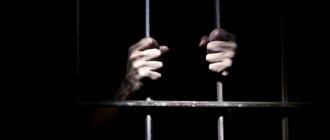Even those who have never been detained in penal institutions have heard about press huts. Every now and then there are reports in the media that a press hut has been discovered in one or another detention center. At the same time, the regional Federal Penitentiary Service always finds a million evidence of the absence of press huts, and then members of the corrupt PSC appear, ready to confirm that the convicts in the next video fought over cigarettes. ZNBM.ru answers one of the popular questions from readers of our channel in Yandex.Zen - what is a press hut in prison.
What is a press hut in prison?
A press hut is a cell into which undesirable convicts are sent in order to be put in their place or to extract the necessary testimony. Despite the fact that press huts also exist in the zone (in colonies), this phenomenon is mainly associated with pre-trial detention centers - pre-trial detention centers.
A press hut in a prison is a phenomenon that is impossible without the support of the administration of the institution. Usually this is a small cell in which physically strong convicts are kept (usually for serious crimes - brutal murders, cannibalism, and so on), who have entered into an agreement with the management of the detention center.
At the right moment, the unwanted convict is transferred to the press hut, after which the inhabitants of the cell carry out educational work with him. For some reason, the in-camera video recorder stops working, and the operative on duty suddenly becomes hard of hearing.
History of creation
The appearance of press cameras is associated with the success of Leica “film” cameras, which fundamentally changed ideas about reportage photography and the limits of photojournalism[1]. The quality of photographic emulsions of the 1930s made it possible to obtain an image on a small-format negative of sufficient quality for newspaper printing, but the resolution was insufficient for magazines. At the same time, the shooting techniques available for the Leica remained unacceptable for conventional large-format equipment. The solution was press cameras, which were widely used from the 1930s to the early 1960s. Cameras of this type were suitable for classical shooting technology with framing and focusing on ground glass, like pavilion and road cameras. Improvements consisted of the appearance of a telescopic viewfinder and rangefinder for quick focusing and framing without removing the cassette. As a result, it became possible to shoot with a press camera handheld in the same way as with a Leica. The only difference was the speed of reloading: while the Leika only needed to turn the crown to change frames, the press cameras required changing the cassette. Over time, instead of single and double cassettes, a “filmpack” for 8 or 10 pictures appeared, and then roller film. Over several decades of improvement, press cameras have made a great contribution to the development of the concept of “systematic” photographic equipment.
Why are press huts needed in prison?
Basically, press huts in prison are used for three things:
- Take out the necessary readings;
- Punish especially zealous defendants (“break”);
- Extort money.
In general, the Russian Criminal Procedure Code (Criminal Procedure Code of the Russian Federation) lays down the principles of division of responsibility - one department (police) detains a person, another (Investigative Committee) conducts the investigation, and contains a third (FSIN). As planned, there are still prosecutors who supervise all this, and judges who administer justice.
In fact, all these organs are intertwined and work together. Police investigators probe a person, collect information and understand his weak points, investigators sew a case, FSI officers extract the necessary testimony, and judges finalize what is happening, sending the person to prison without any special proceedings.
Justice in Russian is when at trial a person is given a sentence that, after recalculation, coincides with the period served in a pre-trial detention center. It turns out that the person is released, but is not acquitted. A criminal record does not count, which is why most of these convicts do not try to defend their rights and demand compensation. They are simply in a hurry to return to ordinary, normal (free) life.
How do they extract testimony in press huts?
Testimony is taken in two situations.
The first is when a person is guilty and tries to “move out”, and the investigator cannot do his job properly and substantiate the accusation.
The second is when a person is not guilty, but the case was “fixed” on him. The investigator in this situation, as a rule, either wants to put a tick in the statistics, or close an inconvenient “hanging fruit” - a case that cannot be solved using traditional methods, but it hangs under the control of one of the bosses.
In both situations, testimony will be forced out of the person. Most likely, he will come out of the press hut either admitting guilt, or lowered, or feet first. Sometimes the person under investigation manages to pay off - in this case, money needs to be given not only to the inhabitants of the press hut, but also to the employees of the institution, and often to the investigator.
How and why do they break things in the press house?
Inconvenient defendants may be sent to the press hut to be “broken.” As a rule, we are talking about particularly zealous advocates of human rights, causing inconvenience to the management of the pre-trial detention center, demanding to call the supervising prosecutor, writing complaints to public figures, and so on.
If such a passenger is sent to the press hut, the task of the torture chamber workers is to put the person in his place and explain how to behave so as not to cause inconvenience to the administration.
How do they break in press huts? Depends on the “client” - it’s enough to scare someone, threaten to disseminate some information, promise to let them down or cause injury. Someone is beaten, someone is tied to a bed (“bunk”) and left in this form for a long time (sometimes a week or more). They can be hung from the chamber grille or from the ceiling. Popular torture and sleep deprivation. A team of bulls takes turns guarding the victim, preventing him from falling asleep for several days. Experienced inmates remember such torture with horror.
They also break you psychologically - with threats, vulgar discussions of relatives (usually women) with details of sexual pleasures with them. Often entering the press hut is accompanied by the imposition of illegal restrictions by the administration. For example, the convict may be limited in delivery, prohibited from visiting, reduced food rations, not given water, or not provided with medical care.
Extortion of money in press huts
Extortion of money is another common activity of press huts. If the administration becomes aware that one of the defendants has money, he can be transferred to the press hut. The forceful or psychological influence of strong men helps the passenger to part with money more easily.
Often funds are shamelessly transferred directly to the personal cards of detention center employees. Divorced people under investigation rarely complain - they worry about their lives and their loved ones. We know of at least several cases when money was transferred “to Sberbank” to BORs - deputy heads of pre-trial detention centers for security and operational work. The editors have no doubt that both the chiefs and representatives of the regional departments of the FSIN have a share.
Notes
- Photocourier, 2005, p. 10.
- ↑ 12
[graflex.org/speed-graphic/ The Graflex Speed Graphic FAQ] Graflex. Retrieved December 19, 2015. - Vladimir Zverev.
[digicam.ru/authors/evolyuciya_fotovspyshek_poltora_veka_puti/ The evolution of flashbulbs.
One and a half centuries of journey] (Russian). Author's articles
. Digital Camera (July 31, 2012). Retrieved December 11, 2015. - KERRI MACDONALD.
[lens.blogs.nytimes.com/2010/01/05/must-33/?_php=true&_type=blogs&_r=0 Must See: He Kept His Speed Graphic] (English).
Photography, Video and Visual Journalism
. Lens (5 January 2010). Retrieved April 26, 2014. - [www.nytimes.com/slideshow/2010/01/03/nyregion/20100103polaroid_index.html Polaroid Photographer] (English). The New York Times. Retrieved April 26, 2014.
Why are press huts possible in prisons?
Unfortunately, the most reasonable answer is because we are in Russia . The rule of law in our country still exists only on paper and in the fictional world of officials. In fact, the one who has more rights is right. Those under investigation, of course, have no rights. Their detention deprived them of even the most basic human right – the right to freedom of movement.
Feeling their strength, the employees of pre-trial detention centers and camps indulge in excess, take advantage of permissiveness and the opportunity to hide their actions behind the iron doors and brick walls of the detention centers. This is a closed zone, and what happens there is a secret, covered with a thick layer of lies from all participants in the process. Almost hothouse conditions for abuse of power.
Permissiveness is also felt by those under investigation (and more often, those already convicted) who “work” in the press huts. The prisoners treat them with contempt, calling such people “woolies” or simply “wool.”
Who are the woollies in prison?
As mentioned above, “woolen” (or simply “wool”) are those prisoners who “work” in the press hut. Other names are also in use - “bulls”, “shaggy” (or even “shaggy” - with a hint of orientation).
As a rule, prisoners treat sextons with disdain. In some institutions (in the “blacker” prisons) it is even worse than in the lower prisons.
Typically, “bulls” are physically strong (often outwardly scary) convicts who are afraid of being transferred to a regular cell or being sent “to the zone.” Such people feel some kind of mistakes behind them - usually associated either with the wrong orientation, or having close relationships with organs. In ordinary huts, on stages and in colonies, these people will face retribution for what they have done. So they decide to stay in prison.
If the “woolen one” does end up in a colony, a rather difficult life awaits him. Often such convicts are forcefully given appropriate tattoos, by which they are easily recognized in any institution. There are known cases when former cellmates, marked in this way, were found free and killed.
As a rule, a whole team works in a press hut - there is a foreman and several of his subordinates. But solitary torture chambers also happen. Often the temporary press hut becomes a punishment cell (or even a “glass”), where the victim is transferred at the same time as the bull. At the same time, the employees of the institution are distracted, and the video recording cameras begin to act up.
In the pre-trial detention center, the woollens live well - they often have telephones, the employees of the operational unit bring them food, drinks, sometimes give them drugs (for good work) or even bring them women. Searches of bulls and searches (“shmonas”) in press huts also happen infrequently and are carried out formally.
References
- ^ a b
Fellig (Weegee), Arthur (2003).
Naked City
(Facsimile, ed.). [Cambridge, MA].: Da Capo Press. item 260. ISBN 0-306-81204-5. - ^ a b c d e
Takahashi, Tim (1996).
"Graflex pacemaker speed graph." photo.net
. Archived from the original on 2002-08-03. Retrieved December 17, 2015. - ^ a b
Adams, Ansel (1980).
Camera
(2nd ed.). Boston: Small, Brown. ISBN 0821210920. - ^ a b
“Which model?”.
www.graflex.org
. Retrieved December 17, 2015. - ^ a b
Caloccia, William;
Takahashi, Timothy. "Speed Graphics FAQ File." RIT Photo Forum
. Retrieved November 27, 2015. - ^ a b
Ruiz, Hugo.
"Identification of Pre-War Ihagi Cameras" (PDF). www.ihagee.org
. Retrieved November 27, 2015. - Atherton, Nigel (2006). Illustrated Digital Photography from A to Z: People and Portraits
. Lausanne, Switzerland: AVA Pub. SA/Essentials. ISBN 2-88479-087-X. - Millett, Larry (2004). Strange days, dangerous nights: photos from the era of high-speed graphics
. St. Paul, MN: Borealis Books. ISBN 0-87351-504-8. Retrieved December 17, 2015. - "Beseler's press chamber." lommen9.home.xs4all.nl
. Retrieved December 17, 2015. - "Joe Lommen Collects and Uses Classic Burke & James Press Chambers." lommen9.home.xs4all.nl
. Retrieved December 17, 2015. - "Bush Camera". lommen9.home.xs4all.nl
. - "Graflex.Org: high-speed graphics, large-format photography and much more." www.graflex.org
. Retrieved December 17, 2015. - "Calarta Camera". www.xs4all.nl
. Retrieved December 17, 2015. - "Linhof Master Technika cameras." www.linhofstudio.com
. Retrieved December 17, 2015. - "Meridian chamber". www.xs4all.nl
. Retrieved December 17, 2015. - "Koni Omega Rapid M - Photoethnography.com Classic Camera Database." www.photoethnography.com
. - "Joe Lommen collects and uses classic PLAUBEL MAKINA II cameras." www.xs4all.nl
. Retrieved December 17, 2015. - "4x5 Press King Camera". graflex.coffsbiz.com
. Retrieved December 17, 2015. - "List of Thornton-Pickard Manufacturing Co. Cameras." Historical Camera History Library
. Retrieved December 17, 2015. - "VanNeck Press Camera." lommen9.home.xs4all.nl
. Retrieved December 17, 2015.
